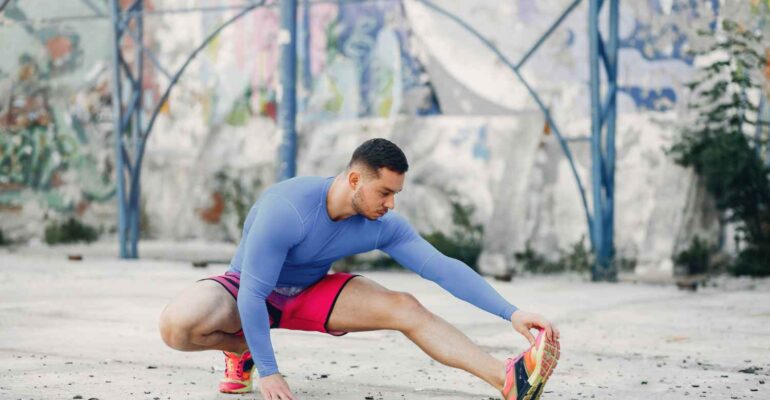Top 8 Lower-Body Exercises to Enhance Muscle Repair
September 21, 2023 2023-09-21 11:54Top 8 Lower-Body Exercises to Enhance Muscle Repair

Top 8 Lower-Body Exercises to Enhance Muscle Repair
Welcome to our article on the top exercises to enhance muscle repair for lower-body Whether you’re a fitness enthusiast, an athlete, or simply someone looking to improve their overall well-being, taking care of your muscles is crucial. After all, they are the powerhouse behind every movement we make. So if you want to optimize your recovery and minimize those achy post-workout days, keep reading!
We’ve compiled a list of eight effective exercises that will help speed up muscle repair and alleviate soreness in your lower-body. Include these into your routine, and get ready to feel stronger, more energized, and ready for your next workout in no time!
Exercise #1: High Knees
High knees are a fantastic exercise to add into your workout routine if you’re looking to enhance muscle repair. This dynamic movement engages multiple muscle groups, including the quadriceps, hamstrings, glutes, and core:
• To perform high knees, simply stand with your feet hip-width apart.
• Begin by lifting one knee up towards your chest while simultaneously driving the opposite arm forward.
• As you lower that leg back down, switch sides and repeat the motion on the other side.
Not only does this exercise help improve cardiovascular endurance and burn calories, but it also activates your fast-twitch muscle fibers – crucial for building strength and power. The repetitive nature of high knees can also promote blood flow to the muscles, aiding in their post-workout recovery.
Whether you do them as part of a warm-up or during an intense interval training session, including high knees into your fitness routine is sure to get your heart rate up while helping support muscle repair and reduce soreness. So do give them a try.
Exercise #2: Butt Kicks
Butt kicks, also known as heel flicks, are a great exercise for muscle recovery and easing soreness. This exercise targets the hamstrings, calves, and glutes while improving flexibility and range of motion in the lower body:
• To perform butt kicks, start by standing with your feet hip-width apart.
• Begin jogging in place while actively kicking your heels up towards your glutes.
• Focus on landing softly on the balls of your feet and maintaining an upright posture throughout the movement.
Butt kicks can be performed as a warm-up or included into a high-intensity interval training (HIIT) workout. They help increase blood flow to the muscles, delivering essential nutrients and oxygen needed for repair and recovery.
Including butt kicks in your exercise routine can also improve coordination and balance. The repetitive motion activates muscle fibers, which are responsible for explosive movements like sprinting or jumping.
Remember to listen to your body when performing any exercise. If you experience pain or discomfort during butt kicks, modify the intensity or consult with a fitness professional for guidance.
Exercise #3: Lateral Shuffle
Want to add a fun and effective exercise to your workout routine? Look no further than the lateral shuffle! This dynamic movement targets multiple muscle groups while also improving coordination and agility:
• To perform the lateral shuffle, start by standing with your feet shoulder-width apart.
• Take a step to the side with one foot, then quickly follow with the other foot.
• Continue moving laterally for a desired number of repetitions or for a set amount of time.
The lateral shuffle primarily works your glutes, quads, hamstrings, and calves. It also engages your core muscles as you maintain balance and stability throughout the movement.
By incorporating this exercise into your routine, you can enhance muscle repair and reduce soreness after intense workouts.
Not only does the lateral shuffle challenge different muscle groups in your lower body, but it also helps improve cardiovascular endurance. Plus, it’s an excellent way to break up monotony in traditional cardio exercises like running or cycling.
Exercise #4: Carioca
Carioca is an exercise that may seem a bit unfamiliar, but it can be incredibly beneficial for muscle repair and reducing soreness. This lateral movement exercise targets the muscles in your hips, glutes, and thighs, helping to improve flexibility and stability:
To perform the carioca exercise:
• Stand with your feet shoulder-width apart.
• Cross your right foot over your left foot and step out to the side.
• Bring your left foot behind your right foot as you cross it over.
• Step out to the side again with your right foot.
• Repeat this crossing motion as you move laterally across the space.
The key to getting the most out of carioca is maintaining proper form throughout each repetition. Keep a slight bend in your knees and engage your core muscles for stability.
Adding on carioca into your workout routine can help increase blood flow to targeted muscles while also enhancing coordination and agility. Plus, it’s a fun way to mix up traditional exercises!
Exercise #5: Skaters
Skaters, also known as lateral jumps, are a fantastic exercise for targeting various muscle groups soreness. This exercise targets the muscles in your legs, especially your glutes, quadriceps, and hamstrings. Skaters not only help build strength but also improve balance and stability:
• To perform skaters, start by standing with your feet hip-width apart.
• Then, jump to one side while swinging the opposite arm across your body.
• Land softly on the other foot and repeat on the other side.
• As you gain confidence and strength, you can increase the speed and distance of your jumps.
Skaters are a dynamic movement that engages multiple muscle groups simultaneously. Doing this exercise into your routine regularly, you can enhance muscle repair by stimulating blood flow to these areas.
Skaters are excellent for reducing soreness after intense workouts or long periods of sitting. They stretch out tight muscles while providing a low-impact cardiovascular workout.
Exercise #6: Bounding
Bounding is a powerful exercise that enhances muscle recovery speed . This explosive movement targets your lower body, specifically the glutes, hamstrings, and quadriceps. It helps to improve strength, power, and agility while also promoting better mobility:
• To perform bounding, start by standing with your feet shoulder-width apart.
• Bend your knees slightly and then jump forward as far as you can using both legs.
• As you land on the balls of your feet, immediately explode into another bound using the opposite leg in front.
This exercise mimics running or sprinting movements but with exaggerated strides. Not only does bounding build muscular strength and endurance but it also increases joint stability by engaging stabilizer muscles throughout the kinetic chain.
Remember to start slowly if you’re new to bounding and gradually increase the intensity as your fitness level improves. And always listen to your body – if any pain or discomfort arises during this exercise, stop immediately.
Exercise #7: Side-to-Side Leg Swings
Side-to-side leg swings are a dynamic exercise that targets the soreness and stiffness in your hips, thighs, and glutes:
• To perform side-to-side leg swings, stand with your feet shoulder-width apart and hold onto a stable object for support if needed.
• Then, swing one leg out to the side as far as comfortable, keeping it straight or slightly bent at the knee.
• Swing it back across your body toward the opposite side, aiming to maintain control throughout the movement.
The swinging motion of this exercise helps increase blood flow to your muscles, allowing for better nutrient delivery and waste removal.
It also stretches and activates the muscles in your hip joint, promoting faster recovery from workouts.
You can start with 10-15 repetitions on each leg and gradually increase as you get more comfortable with the movement.
Exercise #8: Walking High Kicks
Walking high kicks are a great exercise to add into your workout routine to enhance muscle rest and reduce swelling or inflammation. This dynamic movement engages multiple muscle groups, including the hamstrings, glutes, and hip flexors:
• To perform walking high kicks, start by standing with your feet shoulder-width apart.
• Begin walking forward while kicking one leg straight up in front of you, aiming to touch your toes with the opposite hand.
• Keep your core engaged for balance and control.
• As you continue walking forward, alternate legs with each step, repeating the kicking motion on each side.
• Focus on maintaining a steady pace and keeping your movements controlled throughout.
These high kicks not only help increase flexibility in the hamstrings but also promote blood flow to the muscles, aiding in their recovery process. Additionally, they can improve coordination and balance due to their challenging nature.
Remember to listen to your body’s limits when performing any exercise and adjust accordingly. Start with smaller kicks if needed and gradually increase the height of your leg raises as you become more comfortable and flexible.
Conclusion
Adding these exercises into your workout routine can greatly enhance muscle repair and reduce soreness.
In addition to these exercises, proper nutrition and rest are also vital for muscle recovery. Make sure you’re fueling your body with the right nutrients by consuming a balanced diet that includes protein-rich foods like lean meats, eggs, dairy products or plant-based alternatives.
Search
Wellness Topics
This Just In
- Reimagining Traditional Asanas: Modern Variations and Adaptations December 21, 2023
- Iconic Asanas from Classical Yoga Texts: Patanjali and Beyond December 21, 2023
- Exploring the Benefits of Asanas: The Path to Holistic Well-Being December 21, 2023
- The Future of Asanas: Exploring Emerging Practices and Innovations December 21, 2023
- Discovering Yoga’s Roots: Asanas in Vedas and Upanishads December 21, 2023

